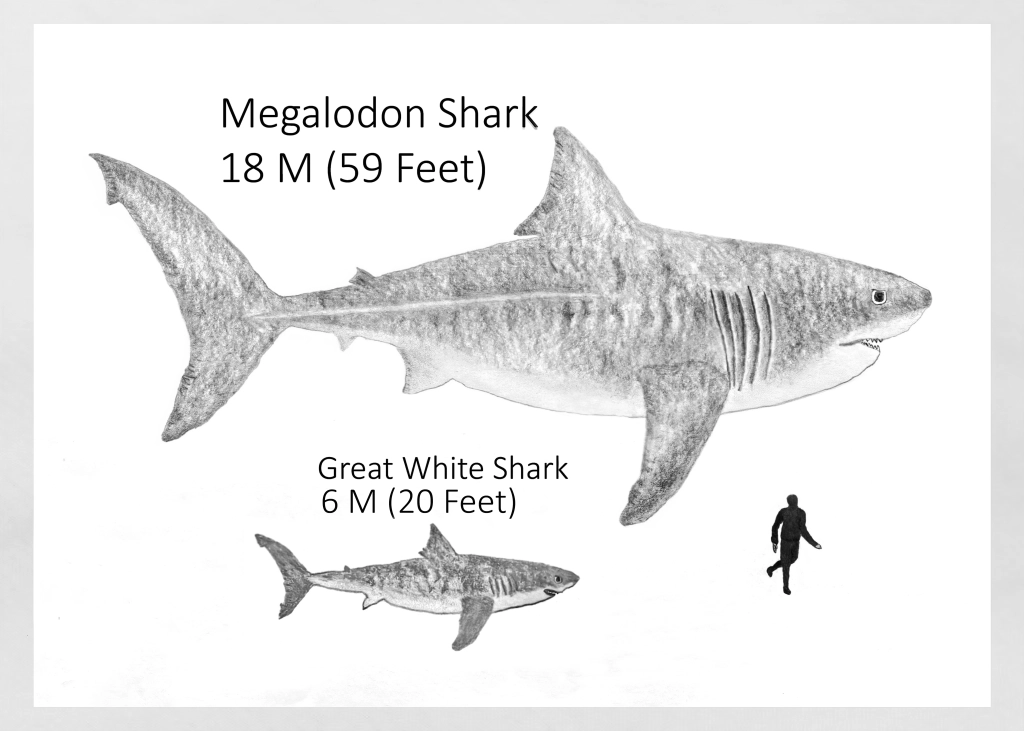
You can find plenty of information on the internet and in books about both of these fascinating creatures, but let’s face it, the magnitude of Megalodon’s girth is mind blowing, as you can see by the comparison drawing above. Keep in mind, these are not their average sizes, but their most exceptional sizes found in the fossil records.
Due to the multitude of unearthed shark teeth, scientists are able to determine size, species and age of these amazing creatures and the fact that the largest Megalodons were female, as with the Great Whites.
Sharks are important to all life on earth keeping the oceans clean of dead debris. Without them, our oceans would be overrun with bad bacteria killing all other ocean life which feed the world.

On average, Great White sharks have approximately 300 teeth, but lose dozens of them per month, which are readily replaced by several rows of backup teeth. In a single lifetime, these sharks can acquire over 20,000 teeth. This would explain why the average beachcomber can readily find volumes to add to their collections! Megalodon had almost as many teeth as the Great Whites, but when you figure in Megalodon’s approximately 20 million-year-timespan on Earth, compared to Great Whites approximate 6 million-year-timespan, it’s not surprising Meg teeth are equally as common to find, if not more.

Comparing Shark Teeth Characteristics
In comparison, Megalodon shark teeth have larger, wider roots than the Great White sharks and typically display a medium to wide bourlette (chevron shaped space between the root and the crown of the tooth). Also, the Megalodon had small, regular spaced serrations along the edges, while the Great White shows thicker, irregular serrations.
Sometimes, the size of the tooth fossil is another way you may tell them apart, depending if the tooth is from a juvenile or an adult. The largest Megalodon tooth ever found is a little over 7 inches (18cm) long, filling a mans palm. The largest recorded Great White shark tooth is just over 3 inches (7.5cm) long.

Where can you find Megalodon teeth?
Megalodon shark teeth have been found on every continent except Antarctica. And in the U.S., their teeth have been found in every state along the East Coast, especially Florida and the Carolinas. Their teeth have also been found in Texas, Louisiana, California, Washington, Hawaii, Michigan and some other Midwestern states. The best environments to find shark teeth are beaches, creek beds, dried riverbeds and abandoned dig sites.
Why did Megalodon become extinct?
Megalodon teeth fossils date from the early Miocene Epoch about 23 million-years-ago until the end of the Pliocene Epoch about 2.58 million-years-ago. Modern Great Whites evolved from the middle of the Miocene Epoch around 10 million-years-ago to the present. Consequently, the Great Whites lived toward the end of Megalodon’s tenure on Earth and scientists predict they competed with juvenile Megalodons for food. Also, changing ocean currents resulting in colder temperatures drove one of Megalodon’s essential prey of whales to colder climates, which Megalodon was not adapted to. A megaton creature needs megatons of food to survive and scientists predict the species was likely starved out of existence.

I originally thought the above shark teeth were from Megalodon, but have since determined they fit better from another breed of large white sharks, possibly, Carcharodon hastalis, an extinct known species found world-wide from marine deposits of the Miocene and Pliocene epochs, around 20 million to 3 million-years-ago. Their teeth are often found right along with the teeth of Megs and on average measure from 1-3 inches (2.5 – 7.5 cm) long, topping out at 4 inches (10 cm) long, second only to Megalodon. Roots of upper teeth are large, but not as broad in comparison, and the crowns lack the edge serrations and chevron shaped bourlette between the crown and roots distinguishable in Megalodon’s.
All rights reserved © Fossillady 2022
Thanks for sending this, v interesting! The video is excellent as well – such enthusiasm. I’m involved to some extent with manatees in the Bahamas, so dugong fossils were a fun find for me…
On ammonites: we live close to the UK ‘Jusassic Coast’ and the local Museum has a good Mary Anning display with fossils. We recently took our 3 granddaughters (5, 7, & 9) to the coast with small hammers and chisels. They had an exciting time collecting little ammonites in blue lias. I’m cleaning the largest.
All the best
Keith @ Rolling Harbour
Hi Keith, Oh my gosh, I would love to go digging for ammonites, but I’m not in the right location. What a fun activity to do with your grandchildren! Best of luck with the manatees! Kathi